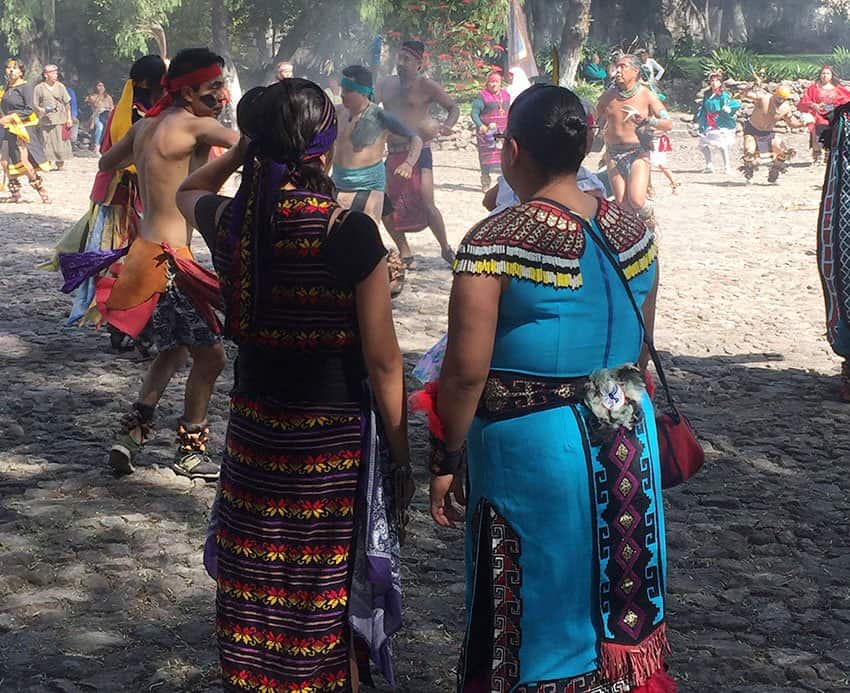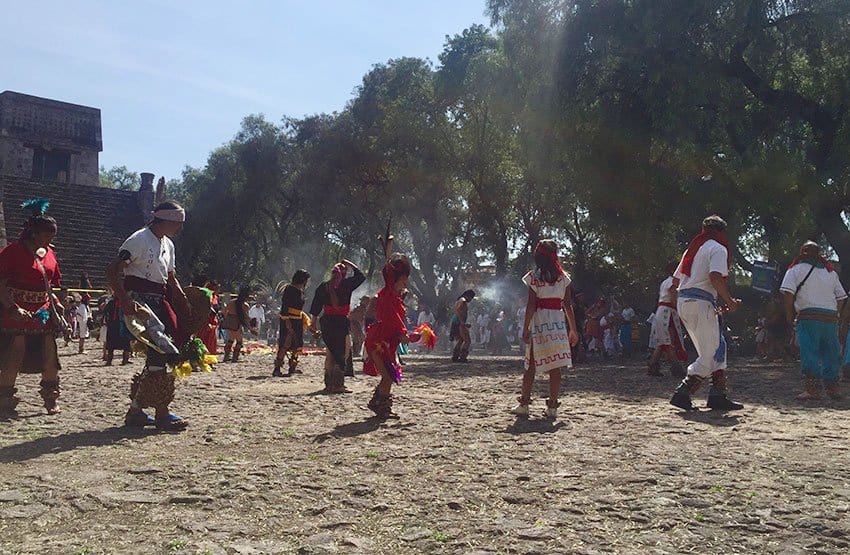The rich smell of copal reached my nose at the same time that I heard a deep, rhythmic drumbeat. I felt a rush of excitement run through me as we moved closer to the small Mesoamerican pyramid set just behind what is now the main square of the small town of Santa Cecilia Acatitlán, a few miles over the border from Mexico City into the state of México.
In the main square, the local priest was giving an outdoor sermon in front of the doors of a small chapel that was adorned with a floral display, complete with jumping dolphins, dedicated to Saint Cecilia.
All around there was a buzz of activity. Unbeknownst to us, the town was celebrating its saint’s day that very Sunday.
The scent of copal led us on. We traversed past the church towards the pyramid which rose up majestically behind it. The small but perfectly restored temple with a rectangular god house on top made me stop in my tracks. Below, a group of perhaps 50 or more traditional Aztec or Mexica dancers moved in unison to the beat of the drum — boom, bo-boom, boom bo-boom — the shells of their ankle cuffs adding a shh-shh-shh-shh as their bare feet hit the earth in perfect time.
They moved from foot to foot, turned in circles and prostrated up and down, holding the rhythm together, creating a hypnotic beat that vibrated through my being. The midday sun scorched the earth but the dancers, who ranged from age seven to 70, continued to move.

Some of the female dancers were dressed in colorful but simple dresses while many of the men wore simple cotton trousers and shirts tied in the middle with a colorful belt. Some dancers also wore more elaborate outfits with huge headdresses full of feathers with stunning turquoise tips, or they had their faces painted to look warrior-like.
Standing under the shade of a mesquite tree, I watched as their feet pounded the earth, as they moved with a spring-like step from side to side and a bouncing movement, as they turned a half circle on one leg. I was entranced. The drumbeat continued to ripple through me.
Before I could become fully hypnotized by the rhythm, I was guided towards the pyramid and we climbed up the steps in a diagonal movement, the steps so narrow that we had to place our feet sideways upon them. Reaching the top, we got a view out over the square below, observing the dancers from above and hearing how the sound traveled up to us.
Not too much is known about the pyramid at Santa Cecilia Acatitlán since information about it wasn’t found in any pre-Hispanic sources. The Institute for Archaeology and History in Mexico (INAH) suggest that this means that the temple would have been abandoned long before the arrival of the Spanish in the 16th century.
While the area was known for the Chichimec and Toltec indigenous groups, the Mexica inhabited this area later and the pyramid was rebuilt in the 1960s, taking into account information known about Mexica temples. The rebuilt pyramid makes for a magnificent and impressive sight. Like the perfectly formed temple seen in photos by National Geographic or Archaeology magazine.
On each side of the top of the temple stairway there were two incensarios upon which fires would have blazed and in the middle there was a sacrificial stone. We were told that the pyramid would have been covered in a thick chalk substance making the whole temple white. With a little imagination, it was easy to envisage the imposing sight that this pyramid — that was part of a ceremonial center — would have made.

We imagined a sacrificial victim arriving at the top of the pyramid, apparently in a rather drunk or drugged state.
“They would be laid over the sacrificial stone and held by the arms and legs before a knife would enter in to their body from under their ribcage to pull the heart out,” our guide told us as the drumbeats continued to echo around the top of the pyramid, a beat as regular as a pulse, as regular as the beat of a living heart.
Something about the scene made it easy to imagine the heady sense of these sacrificial ceremonies and even to imagine how it could be seen as an honor to give your beating heart to the gods.
The god associated with the temple, according to our guide, was Tezcatlipoca, which in Nahuatl means “smoking mirror.”
He was regarded as the god of the night sky and this can be seen in the depiction of stars upon the god house that sits as a magnificent rectangular structure on the top of the temple. On each side there are little round protruding circles that represent stars. We walked around the god house counting them, finding that there were a total of 300.
“This is the number of stars that Tezcatlipoca dominated,” we were told.

The link to astrological bodies is always an important factor in the pyramids of Mesoamerica. This particular pyramid was built facing away from where the sun rises.
“So we know that the rituals here would be performed in spring and summer,” our guide told us before going on to say how people flock to the pyramid for the spring equinox to feel its intense energy at that time.
While busy during the equinox and when there is a Mexica ritual being performed like the day that we visited, the pyramid at Santa Cecilia Acatitlán may have just a handful of visitors each weekend, many preferring to visit the nearby and more well-known Tenayuca pyramids or the impressive site of Teotihuacán.
I took a seat on the top step of the pyramid and watched as the dancers continued to move from leg to leg to the uninterrupted drumbeat. They had been dancing now for at least the hour that we had been there and probably for another hour or so before. The sun was intense and yet they danced without pause, engulfed in copal smoke, their pounding feet creating a light dust in the air.
I wondered if they too feel the delirium or the hypnotic delight that the sacrificial victims would have felt. I wondered if the connection that they felt to their roots kept them grounded to the earth upon which their feet pounded. I wondered who would have stood in the spot upon which I was sat in the years when this ceremonial center was in use and who would have been sacrificed there and why they were chosen.
This pyramid might well be a restored version of the original, since many of the original stones were taken from the temple to build the Catholic church we passed by in the town, but the restoration is so majestic that I couldn’t help but be transported back in time, with the little help from a drumbeat and some 50 or so traditional dancers.
- The pyramid can be reached with a five to 10-minute taxi ride from the Tenayuca Metrobus station, the last station on Línea 3. The taxi should cost 50 pesos.
Susannah Rigg is a freelance writer and Mexico specialist based in Mexico City. Her work has been published by BBC Travel, Condé Nast Traveler, CNN Travel and The Independent UK among others. Find out more about Susannah on her website.
